Domain And Range Of Inverse
1.seven: Inverse Functions
- Page ID
- 1299
Learning Objectives
- Verify inverse functions.
- Determine the domain and range of an inverse function, and restrict the domain of a function to make it i-to-one.
- Find or evaluate the inverse of a function.
- Employ the graph of a one-to-i role to graph its inverse part on the aforementioned axes.
A reversible heat pump is a climate-control organisation that is an air conditioner and a heater in a single device. Operated in 1 direction, it pumps heat out of a house to provide cooling. Operating in contrary, it pumps heat into the building from the outside, even in cool weather, to provide heating. As a heater, a oestrus pump is several times more efficient than conventional electrical resistance heating.
If some physical machines can run in two directions, we might ask whether some of the function "machines" we have been studying can likewise run backwards. Figure \(\PageIndex{1}\) provides a visual representation of this question. In this section, we will consider the opposite nature of functions.
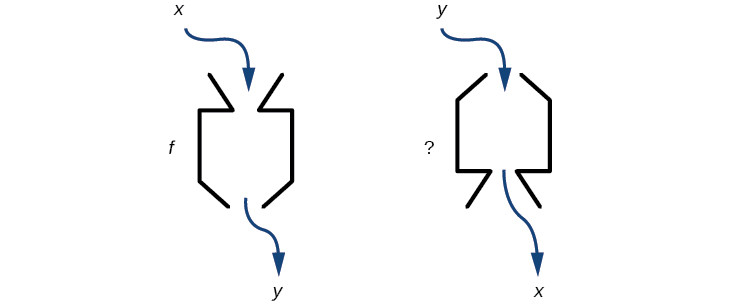
Effigy \(\PageIndex{1}\): Tin can a role "car" operate in reverse?
Verifying That 2 Functions Are Changed Functions
Suppose a fashion designer traveling to Milan for a fashion show wants to know what the temperature volition be. He is not familiar with the Celsius calibration. To get an idea of how temperature measurements are related, he asks his assistant, Betty, to catechumen 75 degrees Fahrenheit to degrees Celsius. She finds the formula
\[C=\dfrac{5}{9}(F−32)\]
and substitutes 75 for \(F\) to calculate
\[\dfrac{5}{9}(75−32)\approx24^{\circ}\]
Knowing that a comfortable 75 degrees Fahrenheit is about 24 degrees Celsius, he sends his assistant the calendar week's atmospheric condition forecast from Figure \(\PageIndex{2}\) for Milan, and asks her to convert all of the temperatures to degrees Fahrenheit.

At start, Betty considers using the formula she has already plant to consummate the conversions. Afterwards all, she knows her algebra, and can hands solve the equation for \(F\) afterward substituting a value for \(C\). For example, to catechumen 26 degrees Celsius, she could write
\[\begin{align} 26&=\dfrac{v}{nine}(F-32) \\ 26⋅\dfrac{ix}{5}&=F−32 \\ F&=26⋅\dfrac{9}{v}+32\approx79\end{align}\]
After considering this selection for a moment, yet, she realizes that solving the equation for each of the temperatures will be clumsily tedious. She realizes that since evaluation is easier than solving, it would be much more convenient to have a dissimilar formula, ane that takes the Celsius temperature and outputs the Fahrenheit temperature.
The formula for which Betty is searching corresponds to the idea of an changed function, which is a office for which the input of the original function becomes the output of the inverse function and the output of the original role becomes the input of the inverse function.
Given a function \(f(10)\), we represent its inverse every bit \(f^{−ane}(x)\), read as "\(f\) inverse of \(x\)." The raised −i is part of the annotation. Information technology is not an exponent; it does not imply a power of −1 . In other words, \(f^{−i}(x)\) does not mean \(\frac{one}{f(x)}\) considering \(\frac{1}{f(x)}\) is the reciprocal of \(f\) and not the inverse.
The "exponent-like" notation comes from an analogy between function limerick and multiplication: just as \(a^{−ane}a=one\) (one is the identity element for multiplication) for any nonzero number \(a\), and so \(f^{−i}{\circ}f\) equals the identity function, that is,
\[(f^{−1}{\circ}f)(x)=f^{−1}(f(ten))=f^{−1}(y)=x\]
This holds for all \(x\) in the domain of \(f\). Informally, this means that inverse functions "undo" each other. Even so, just every bit aught does not have a reciprocal, some functions do not accept inverses.
Given a part \(f(x)\), nosotros can verify whether some other function \(g(10)\) is the inverse of \(f(10)\) by checking whether either \(g(f(x))=10\) or \(f(one thousand(10))=x\) is true. We tin test whichever equation is more user-friendly to work with because they are logically equivalent (that is, if one is true, then and then is the other.)
For case, \(y=4x\) and \(y=\frac{i}{4}10\) are inverse functions.
\[(f^{−1}{\circ}f)(ten)=f^{-1}(4x)=\dfrac{ane}{iv}(4x)=x\]
and
\[(f{\circ}f^{−1})(10)=f\Large(\dfrac{1}{4}x\Big)=4\Big(\dfrac{1}{4}x\Big)=x\]
A few coordinate pairs from the graph of the role \(y=4x\) are \((−ii, −8)\), \((0, 0)\), and \((2, 8)\). A few coordinate pairs from the graph of the office \(y=\frac{1}{4}ten\) are \((−8, −2)\), \((0, 0)\), and \((8, two)\). If we interchange the input and output of each coordinate pair of a function, the interchanged coordinate pairs would appear on the graph of the changed function.
Definition: Changed Role
For any i-to-one function \(f(ten)=y\), a function \(f^{−1}(10)\) is an inverse function of \(f\) if \(f^{−1}(y)=ten\). This can as well exist written every bit \(f^{−1}(f(x))=x\) for all \(x\) in the domain of \(f\). It likewise follows that \(f(f^{−ane}(x))=x\) for all \(x\) in the domain of \(f^{−1}\) if \(f^{−1}\) is the inverse of \(f\).
The notation \(f^{−1}\) is read "\(f\) inverse." Like any other function, nosotros tin can use whatsoever variable name equally the input for \(f^{−1}\), then we will often write \(f^{−1}(x)\), which nosotros read as "\(f\) inverse of \(ten\)." Keep in mind that
\[f^{−ane}(x)\neq\dfrac{1}{f(x)}\]
and not all functions have inverses.
Case \(\PageIndex{1}\): Identifying an Inverse Function for a Given Input-Output Pair
If for a item i-to-one part \(f(two)=iv\) and \(f(v)=12\), what are the corresponding input and output values for the inverse function?
Solution
The inverse role reverses the input and output quantities, so if
\[f(2)=4, \text{ and so } f^{-1}(4)=ii ;\\ f(v)=12, \text{ then }f^{-1}(12)=5\].
Alternatively, if we want to proper noun the changed function \(g\), and so \(g(4)=2\) and \(yard(12)=5\).
Analysis
Find that if nosotros bear witness the coordinate pairs in a table course, the input and output are clearly reversed. See Tabular array \(\PageIndex{1}\).
| \((ten,f(x))\) | \((ten,g(10))\) |
|---|---|
| \((ii,4)\) | \((4,ii)\) |
| \((5,12)\) | \((12,v)\) |
Exercise \(\PageIndex{1}\)
Given that \(h^{-1}(6)=2\), what are the corresponding input and output values of the original function \(h\)?
- Answer
-
\(h(2)=6\)
How To: Given two functions \(f(x)\) and \(g(x)\), test whether the functions are inverses of each other.
- Decide whether \(f(g(10))=x\) or \(g(f(x))=x\).
- If both statements are true, then \(g=f^{-1}\) and \(f=g^{-1}\). If either statement is false, then both are simulated, and \(g{\neq}f^{-1}\) and \(f{\neq}one thousand^{-1}\).
Example \(\PageIndex{2}\): Testing Changed Relationships Algebraically
If \(f(10)=\frac{1}{x+2}\) and \(g(x)=\frac{i}{x}−2\), is \(thou=f^{-1}\)?
Solution
\[\begin{align} k(f(ten))&=\dfrac{1}{(\frac{1}{x+2})−2} \\ &=10+2−ii \\&=x \end{align}\]
so
\[g=f^{-1} \text{ and } f=g^{-1}\]
This is enough to respond yes to the question, but we tin can also verify the other formula.
\[\begin{align} f(one thousand(x))&=\dfrac{1}{\frac{1}{x}-two+2} \\ &= \dfrac{1}{\frac{1}{10}} \\ &=x \end{align}\]
Assay
Observe the changed operations are in reverse order of the operations from the original function.
Exercise \(\PageIndex{ii}\)
If \(f(10)=10^iii−4\) and \(g(x)=\sqrt[3]{ten+4}\), is \(g=f^{-one}\)?
- Respond
-
Yeah
Example \(\PageIndex{iii}\): Determining Changed Relationships for Power Functions
If \(f(x)=x^3\) (the cube office) and \(chiliad(10)=\frac{1}{3}x\), is \(g=f^{-1}\)?
Solution
\[f(g(ten))=\dfrac{x^3}{27}{\neq}ten\]
No, the functions are not inverses.
Analysis
The correct inverse to the cube is, of course, the cube root \(\sqrt[iii]{x}=x^{\frac{ane}{three}}\), that is, the 1-third is an exponent, not a multiplier.
Exercise \(\PageIndex{iii}\)
If \(f(10)=(10−1)^3\) and \(g(10)=\sqrt[3]{10}+i\), is \(k=f^{-one}\)?
- Answer
-
Yes
Finding Domain and Range of Inverse Functions
The outputs of the function \(f\) are the inputs to \(f^{-one}\), so the range of \(f\) is also the domain of \(f^{-1}\). Too, because the inputs to \(f\) are the outputs of \(f^{-i}\), the domain of \(f\) is the range of \(f^{-1}\). We can visualize the situation equally in Figure \(\PageIndex{three}\).

Figure \(\PageIndex{3}\): Domain and range of a part and its inverse.
When a function has no inverse function, it is possible to create a new office where that new function on a express domain does accept an inverse function. For example, the inverse of \(f(x)=\sqrt{x}\) is \(f^{-one}(x)=ten^ii\), because a square "undoes" a square root; merely the square is only the inverse of the square root on the domain \(\left[0,\infty\right)\), since that is the range of \(f(x)=\sqrt{ten}\).
We can look at this problem from the other side, starting with the square (toolkit quadratic) function \(f(x)=x^ii\). If we want to construct an inverse to this function, we come across a problem, considering for every given output of the quadratic function, there are two respective inputs (except when the input is 0). For example, the output nine from the quadratic function corresponds to the inputs 3 and –three. Only an output from a office is an input to its inverse; if this inverse input corresponds to more than one changed output (input of the original part), and then the "inverse" is non a function at all! To put it differently, the quadratic role is non a one-to-ane function; information technology fails the horizontal line test, so it does not have an changed function. In order for a function to accept an inverse, it must exist a ane-to-ane function.
In many cases, if a function is not one-to-one, we tin can even so restrict the part to a office of its domain on which it is i-to-one. For example, we tin make a restricted version of the square function \(f(ten)=ten^2\) with its range limited to \(\left[0,\infty\right)\), which is a ane-to-one office (information technology passes the horizontal line test) and which has an changed (the square-root office).
If \(f(x)=(x−1)^2\) on \([one,∞)\), then the inverse function is \(f^{-1}(x)=\sqrt{10}+ane\).
- The domain of \(f\) = range of \(f^{-1} = \left[1,\infty\correct)\).
- The domain of \(f^{-1}\) = range of \(f = \left[0,\infty\right)\).
![]() Is it possible for a function to have more than i inverse?
Is it possible for a function to have more than i inverse?
No. If two supposedly dissimilar functions, say, \(thou\) and h, both meet the definition of beingness inverses of some other function \(f\), then you lot can bear witness that \(g=h\). We have just seen that some functions merely have inverses if nosotros restrict the domain of the original office. In these cases, in that location may be more than i fashion to restrict the domain, leading to different inverses. All the same, on any ane domain, the original function still has only 1 unique inverse.
Note: Domain and Range of Inverse Functions
The range of a function \(f(x)\) is the domain of the inverse part \(f^{-1}(10)\).
The domain of \(f(x)\) is the range of \(f^{-1}(ten)\).
How To: Given a function, detect the domain and range of its changed.
- If the role is one-to-one, write the range of the original part as the domain of the inverse, and write the domain of the original function as the range of the inverse.
- If the domain of the original role needs to be restricted to brand it one-to-i, then this restricted domain becomes the range of the inverse function.
Example \(\PageIndex{four}\): Finding the Inverses of Toolkit Functions
Identify which of the toolkit functions as well the quadratic function are not one-to-ane, and find a restricted domain on which each office is one-to-one, if any. The toolkit functions are reviewed in Table \(\PageIndex{2}\). We restrict the domain in such a fashion that the function assumes all y-values exactly once.
| Constant | Identity | Quadratic | Cubic | Reciprocal |
|---|---|---|---|---|
| \(f(x)=c\) | \(f(x)=10\) | \(f(10)=x^2\) | \(f(x)=x^3\) | \(f(x)=\frac{1}{10}\) |
| Reciprocal squared | Cube Root | Square Root | Absolute Value | |
| \(f(ten)=\frac{1}{10^two}\) | \(f(ten)=\sqrt[3]{x}\) | \(f(x)=\sqrt{x}\) | \(f(x)=|10|\) |
Solution
The abiding function is not one-to-i, and there is no domain (except a single point) on which it could be one-to-one, then the constant function has no meaningful inverse.
The absolute value office tin can exist restricted to the domain \(\left[0,\infty\right)\),where it is equal to the identity office.
The reciprocal-squared function tin be restricted to the domain \((0,\infty)\).
Analysis
We can see that these functions (if unrestricted) are not i-to-one by looking at their graphs, shown in Figure \(\PageIndex{4}\). They both would neglect the horizontal line test. Nonetheless, if a function is restricted to a certain domain so that it passes the horizontal line examination, so in that restricted domain, it can take an inverse.
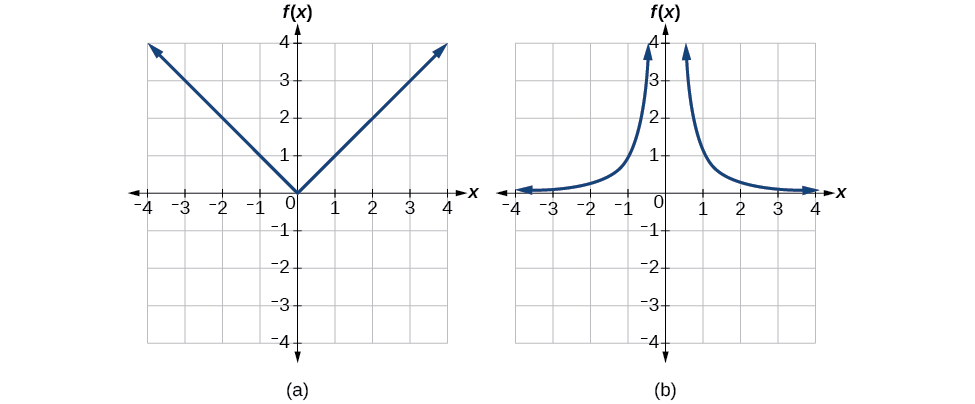
Figure \(\PageIndex{4}\): (a) Absolute value (b) Reciprocal squared
![]() \(\PageIndex{4}\): The domain of function \(f\) is \((i,\infty)\) and the range of function \(f\) is \((−\infty,−2)\). Find the domain and range of the inverse part.
\(\PageIndex{4}\): The domain of function \(f\) is \((i,\infty)\) and the range of function \(f\) is \((−\infty,−2)\). Find the domain and range of the inverse part.
Solution
The domain of function \(f^{-1}\) is \((−\infty,−two)\) and the range of part \(f^{-1}\) is \((1,\infty)\).
Finding and Evaluating Changed Functions
Once we have a one-to-one function, we can evaluate its inverse at specific inverse function inputs or construct a complete representation of the changed function in many cases.
Inverting Tabular Functions
Suppose we desire to discover the changed of a office represented in table course. Remember that the domain of a function is the range of the inverse and the range of the role is the domain of the changed. So we demand to interchange the domain and range.
Each row (or cavalcade) of inputs becomes the row (or cavalcade) of outputs for the inverse function. Similarly, each row (or column) of outputs becomes the row (or column) of inputs for the inverse function.
Example \(\PageIndex{5}\): Interpreting the Inverse of a Tabular Function
A office \(f(t)\) is given in Table \(\PageIndex{3}\), showing distance in miles that a auto has traveled in \(t\) minutes. Find and interpret \(f^{-1}(70)\)
| \(t\) (minutes) | thirty | 50 | lxx | 90 |
|---|---|---|---|---|
| \(f(t)\) (miles) | 20 | forty | lx | 70 |
The inverse part takes an output of \(f\) and returns an input for \(f\). Then in the expression \(f^{-1}(lxx)\), 70 is an output value of the original function, representing 70 miles. The inverse will return the corresponding input of the original function \(f\), xc minutes, and then \(f^{-i}(70)=ninety\). The interpretation of this is that, to drive lxx miles, it took ninety minutes.
Alternatively, retrieve that the definition of the inverse was that if \(f(a)=b\), then \(f^{-1}(b)=a\). By this definition, if we are given \(f^{-one}(70)=a\), then we are looking for a value \(a\) and then that \(f(a)=70\). In this case, we are looking for a \(t\) then that \(f(t)=70\), which is when \(t=90\).
Do \(\PageIndex{v}\)
Using Table \(\PageIndex{four}\), find and interpret (a) \(f(60)\),and (b) \(f^{-1}(60)\).
| \(t\) (minutes) | 30 | 50 | sixty | 70 | 90 |
|---|---|---|---|---|---|
| \(f(t)\) (miles) | xx | xl | 50 | 60 | lxx |
- Answer
-
\(f(60)=fifty\). In hour, l miles are traveled.
\(f^{-1}(60)=70\). To travel 60 miles, it will take 70 minutes.
Evaluating the Inverse of a Function, Given a Graph of the Original Role
We saw in Functions and Part Notation that the domain of a function tin can be read past observing the horizontal extent of its graph. We find the domain of the inverse part past observing the vertical extent of the graph of the original office, because this corresponds to the horizontal extent of the changed function. Similarly, we find the range of the inverse office by observing the horizontal extent of the graph of the original office, as this is the vertical extent of the inverse role. If we want to evaluate an inverse role, we find its input within its domain, which is all or office of the vertical axis of the original function's graph.
![]() Given the graph of a office, evaluate its inverse at specific points.
Given the graph of a office, evaluate its inverse at specific points.
- Find the desired input on the y-centrality of the given graph.
- Read the changed function's output from the x-centrality of the given graph.
Example \(\PageIndex{half dozen}\): Evaluating a Function and Its Inverse from a Graph at Specific Points
A function \(g(10)\) is given in Figure \(\PageIndex{five}\). Observe \(thousand(three)\) and \(m^{-1}(three)\).
.
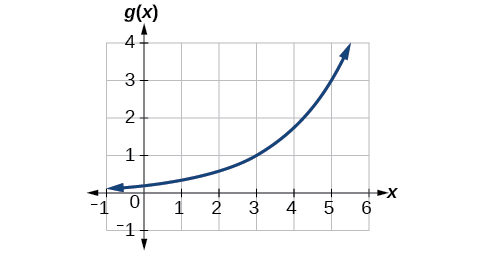
Solution
To evaluate \(thousand(3)\), we detect 3 on the x-axis and find the corresponding output value on the y-axis. The betoken \((3,1)\) tells us that \(g(3)=1\).
To evaluate \(g^{-1}(iii)\), recall that by definition \(thou^{-1}(3)\) means the value of \(x\) for which \(g(x)=3\). By looking for the output value iii on the vertical axis, we find the bespeak \((5,3)\) on the graph, which ways \(g(v)=3\), and then by definition, \(grand^{-1}(3)=5.\) Encounter Figure \(\PageIndex{6}\).
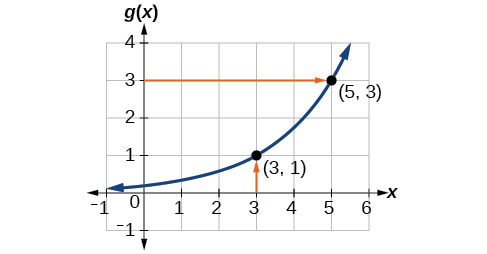
Do \(\PageIndex{half dozen}\)
Using the graph in Figure \(\PageIndex{6}\), (a) find \(grand^{-1}(1)\),and (b) estimate \(g^{-1}(4)\).
- Answer a
-
iii
- Answer b
-
5.6
Finding Inverses of Functions Represented by Formulas
Sometimes nosotros will need to know an changed function for all elements of its domain, not just a few. If the original function is given as a formula— for example, \(y\) equally a function of \(x\)— we can often find the inverse role by solving to obtain \(x\) equally a function of \(y\).
How To: Given a function represented by a formula, find the inverse.
- Make certain \(f\) is a one-to-i function.
- Solve for \(ten\)
- Interchange \(x\) and \(y\).
Example \(\PageIndex{7}\): Inverting the Fahrenheit-to-Celsius Office
Find a formula for the inverse function that gives Fahrenheit temperature as a office of Celsius temperature.
\[C=\dfrac{5}{9}(F−32)\]
Solution
\[\begin{marshal} C&=\frac{v}{9}(F-32) \\ C{\cdot}\frac{9}{five}&=F−32 \\ F&=\frac{9}{5}C+32\terminate{align}\]
Past solving in full general, we have uncovered the inverse office. If
\[C=h(F)=\dfrac{v}{9}(F−32)\],
and then
\[F=h^{-i}(C)=\dfrac{9}{v}C+32.\]
In this case, we introduced a function \(h\) to represent the conversion because the input and output variables are descriptive, and writing \(C^{-ane}\) could get confusing.
Practice \(\PageIndex{seven}\)
Solve for \(ten\) in terms of \(y\) given \(y=\frac{1}{3}(x−v)\)
- Reply
-
\(10=3y+5\)
Example \(\PageIndex{eight}\): Solving to Observe an Inverse Function
Find the inverse of the part \(f(10)=\frac{2}{x−3}+iv\).
Solution
\[\begin{marshal} y&=\dfrac{two}{x−3+4} &\text{Gear up upward an equation.} \\ y−4&=\dfrac{ii}{x−3} &\text{Subtract four from both sides.} \\ x−3&=\dfrac{2}{y−iv} &\text{Multiply both sides by x−3 and split past y−iv.} \\ x&=\dfrac{2}{y−4}+3 &\text{Add 3 to both sides.} \end{align}\]
So \(f^{-1}(y)=\frac{2}{y−4}+three\) or \(f^{-ane}(ten)=\frac{2}{10−4}+three\).
Analysis
The domain and range of \(f\) exclude the values 3 and four, respectively. \(f\) and \(f^{-1}\) are equal at two points but are non the same part, as nosotros can see by creating Table \(\PageIndex{five}\).
| \(x\) | i | 2 | 5 | \(f^{-1}(y)\) |
|---|---|---|---|---|
| \(f(x)\) | three | 2 | 5 | \(y\) |
Example \(\PageIndex{9}\): Solving to Discover an Inverse with Radicals
Find the inverse of the function \(f(x)=two+\sqrt{x−4}\).
Solution
\[ \begin{align} y&=2+\sqrt{x-4} \\ (y-2)^2&=ten-4 \\ x&=(y-2)^2+4 \finish{align}\]
So \(f^{-1}(ten)=(x−2)^two+4\).
The domain of \(f\) is \(\left[4,\infty\right)\). Notice that the range of \(f\) is \(\left[two,\infty\right)\), so this means that the domain of the changed role \(f^{-1}\) is also \(\left[2,\infty\right)\)
Assay
The formula we plant for \(f^{-i}(x)\) looks like it would be valid for all real \(x\). However, \(f^{-1}\) itself must take an inverse (namely, \(f\) ) and so we have to restrict the domain of \(f^{-1}\) to \(\left[2,\infty\right)\) in order to make \(f^{-1}\) a one-to-one role. This domain of \(f^{-one}\) is exactly the range of \(f\).
Practise \(\PageIndex{8}\)
What is the inverse of the function \(f(x)=2-\sqrt{ten}\)? State the domains of both the function and the inverse function.
- Answer
-
\(f^{-1}(x)=(2−x)^2\); domain of \(f\): \(\left[0,\infty\right)\); domain of \(f^{-one}\): \(\left(−\infty,2\right]\)
Finding Inverse Functions and Their Graphs
Now that we can discover the inverse of a role, we will explore the graphs of functions and their inverses. Let us return to the quadratic function \(f(x)=x^2\) restricted to the domain \(\left[0,\infty\right)\), on which this function is 1-to-one, and graph information technology equally in Figure \(\PageIndex{7}\).
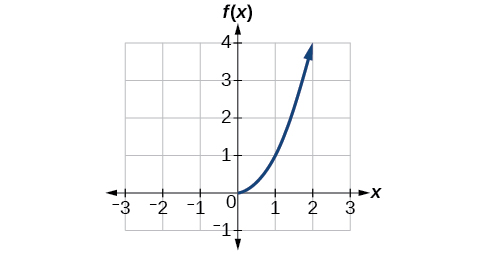
Figure \(\PageIndex{seven}\): Quadratic function with domain restricted to \([0, \infty)\).
Restricting the domain to \(\left[0,\infty\right)\) makes the role one-to-one (it volition obviously pass the horizontal line exam), and then information technology has an inverse on this restricted domain.
We already know that the inverse of the toolkit quadratic function is the square root part, that is, \(f^{-1}(10)=\sqrt{x}\). What happens if we graph both \(f\) and \(f^{-1}\) on the same ready of axes, using the 10-axis for the input to both \(f\) and \(f^{-1}\)?
We discover a distinct human relationship: The graph of \(f^{-1}(x)\) is the graph of \(f(x)\) reflected about the diagonal line \(y=10\), which nosotros will call the identity line, shown in Figure \(\PageIndex{8}\).
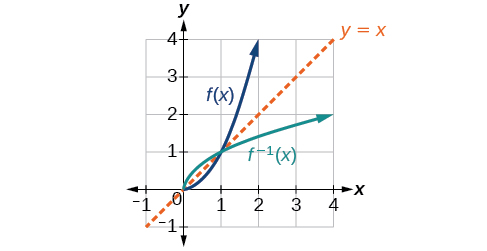 .
.
Figure \(\PageIndex{8}\): Foursquare and square-root functions on the non-negative domain
This relationship volition be observed for all one-to-one functions, because it is a result of the function and its inverse swapping inputs and outputs. This is equivalent to interchanging the roles of the vertical and horizontal axes.
Case \(\PageIndex{10}\): Finding the Inverse of a Role Using Reflection nearly the Identity Line
Given the graph of \(f(x)\) in Figure \(\PageIndex{nine}\), sketch a graph of \(f^{-one}(x)\).
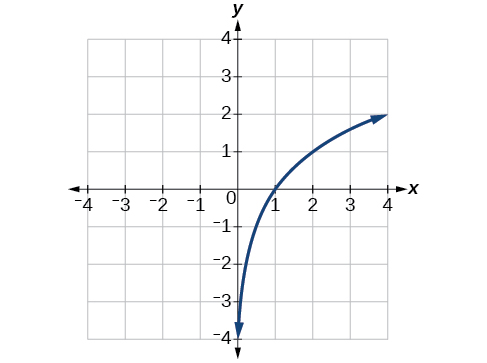
This is a 1-to-one function, so we will exist able to sketch an inverse. Notation that the graph shown has an credible domain of \((0,\infty)\) and range of \((−\infty,\infty)\), so the changed will accept a domain of \((−\infty,\infty)\) and range of \((0,\infty)\).
If we reflect this graph over the line \(y=x\), the bespeak \((one,0)\) reflects to \((0,1)\) and the betoken \((4,ii)\) reflects to \((two,iv)\). Sketching the inverse on the same axes as the original graph gives Figure \(\PageIndex{10}\).
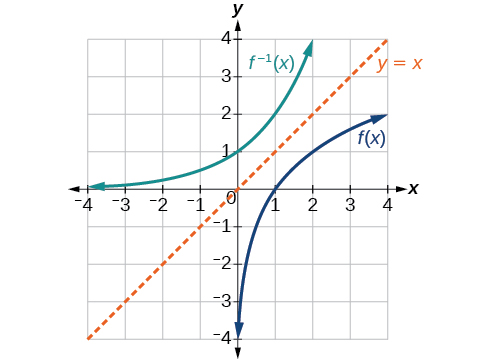
Exercise \(\PageIndex{1}\)
Describe graphs of the functions \(f\) and \(f^{-1}\) from Instance \(\PageIndex{8}\).
- Reply
-
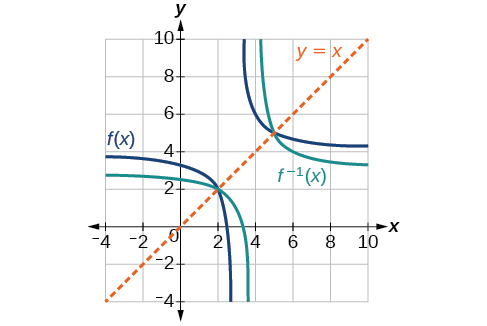
Figure \(\PageIndex{11}\): Graph of \(f(x)\) and \(f^(-i)(ten)\).
![]() Is there any role that is equal to its own inverse?
Is there any role that is equal to its own inverse?
Yes. If \(f=f^{-i}\), then \(f(f(x))=ten\), and we can think of several functions that take this property. The identity function
does, and then does the reciprocal function, because
\[\dfrac{1}{\frac{1}{x}}=10\]
Whatsoever part \(f(x)=c−10\), where \(c\) is a constant, is also equal to its ain inverse.
Primal Concepts
- If \(m(ten)\) is the inverse of \(f(ten)\), and then \(g(f(ten))=f(g(x))=10\).
- Each of the toolkit functions has an changed.
- For a function to have an inverse, it must be ane-to-one (laissez passer the horizontal line test).
- A function that is non one-to-one over its entire domain may be one-to-one on role of its domain.
- For a tabular part, exchange the input and output rows to obtain the changed.
- The inverse of a function can be adamant at specific points on its graph.
- To find the changed of a formula, solve the equation \(y=f(x)\) for \(ten\) as a role of \(y\). And so exchange the labels \(x\) and \(y\).
- The graph of an changed function is the reflection of the graph of the original function beyond the line \(y=x\).
Domain And Range Of Inverse,
Source: https://math.libretexts.org/Bookshelves/Precalculus/Precalculus_%28OpenStax%29/01:_Functions/1.07:_Inverse_Functions
Posted by: nettlessubsed.blogspot.com


0 Response to "Domain And Range Of Inverse"
Post a Comment